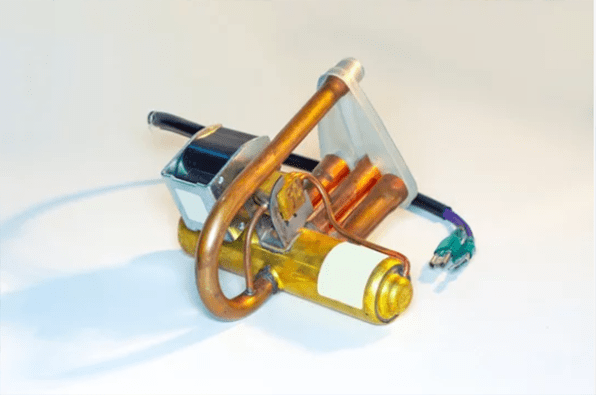
Figure 1: Heat pump outdoor units.
Heat pumps are a popular HVAC system for homeowners, thanks to their energy efficiency and ability to provide both heating and cooling. However, like any mechanical system, heat pumps can experience problems that prevent them from turning on. If your heat pump is not turning on, there are several reasons why this may be happening.
In this article, we will explore some of the most common causes of a heat pump not turning on (heat pump not kicking on) and provide troubleshooting tips to help you get your system back up and running.
1. Troubleshooting Tips: Why is My Heat Pump Not Turning on
1.1 Check the Thermostat
One of the most common reasons why your heat pump may not be turning on is an issue with the thermostat. If the thermostat is not working correctly, it can prevent the heat pump from turning on. Make sure that the thermostat is set to the correct temperature and that it is set to the appropriate mode (heating or cooling).
If the thermostat is battery-powered, check that the batteries are not dead and replace them if necessary. If the thermostat is programmable, make sure that the program is set correctly and that the system is not in an "off" mode.

Figure 2: Heat pump thermostat.
1.2 Check the Circuit Breaker
If your thermostat appears to be functioning properly, the next step is to check your circuit breaker. A tripped circuit breaker can prevent your heat pump from turning on. Locate your electrical panel and look for any tripped breakers. If you find one, reset it by flipping it off and then back on again.
If the breaker continues to trip, it may indicate a more serious electrical problem that requires the assistance of a professional technician.
1.3 Check the Capacitor
The capacitor is an electrical component that helps to start the compressor in the outdoor unit of the heat pump. If the capacitor is faulty, it can prevent the compressor from starting, which can cause the system to not turn on. A professional HVAC technician can diagnose and replace a faulty capacitor.

Figure 3: Air conditioner capacitor.
1.4 Check the Air Filter
A dirty air filter can cause your heat pump to stop working. If the air filter is clogged with dirt and debris, it can restrict airflow and cause the system to shut down.
Make sure to check the air filter and replace it if it is dirty. It is recommended to replace air filters every 1-3 months, depending on the level of usage.
1.5 Check the Outdoor Unit
Your outdoor unit plays an important role in the functioning of your heat pump. If it is blocked by debris or obstructed in any way, it can prevent your heat pump from turning on.
Clear away any debris such as leaves, twigs, or grass clippings that may be blocking the outdoor unit. Also, make sure that the unit is not covered by snow or ice in the winter months.

Figure 4: A heat pump surrounded by snow.
1.6 Check the Defrost Control Board
If your heat pump is not turning on during cold weather, the problem may be with the defrost control board. The defrost control board is responsible for initiating the defrost cycle, which melts any ice that has formed on the outdoor unit.
If the defrost control board is faulty, it may prevent the defrost cycle from starting, which can cause the heat pump to not turn on. A professional HVAC technician can diagnose and replace a faulty defrost control board.
1.7 Check the Reversing Valve
The reversing valve is responsible for switching the heat pump from heating to cooling mode. If the reversing valve is stuck, it can prevent the system from turning on. A professional HVAC technician can diagnose and repair a faulty reversing valve.

Figure 5: 4 way reversing valve.
1.8 Check the Refrigerant Level
Low refrigerant levels can cause your heat pump to stop working. If the refrigerant level is low, it can cause the system to freeze up, which can damage the compressor and other components. If you suspect that the refrigerant level is low, it is important to call a professional HVAC technician to diagnose and repair the problem.
2. Call a Professional Technician
If none of the above troubleshooting tips solve the problem of your heat pump not turning on, it may be time to call a professional technician. A qualified HVAC technician can diagnose the problem and provide the necessary repairs or replacements to get your heat pump up and running again.
3. Conclusion
A heat pump not turning on can be a frustrating problem for homeowners, but there are several reasons why this may be happening. From a faulty thermostat to a low refrigerant level, there are many potential causes of a heat pump not turning on.
By following the troubleshooting tips outlined in this article, you can identify the problem and take steps to get your heat pump back up and running. If you are unable to diagnose or fix the problem on your own, it is important to call a professional HVAC technician to diagnose and repair the issue.
Related Info
Heat Pump vs Mini Split: Which is Better for Your Home?How Do I Know If I Have a Heat Pump or an AC? A Comprehensive Guide
How Does a Pool Heater Work? (4 Types Pool Heaters Explained)
Dual Fuel Heat Pump: Everything You Need to Know
Heat Pump Troubleshooting Chart: A Comprehensive Guide to Diagnosing Common Issues


